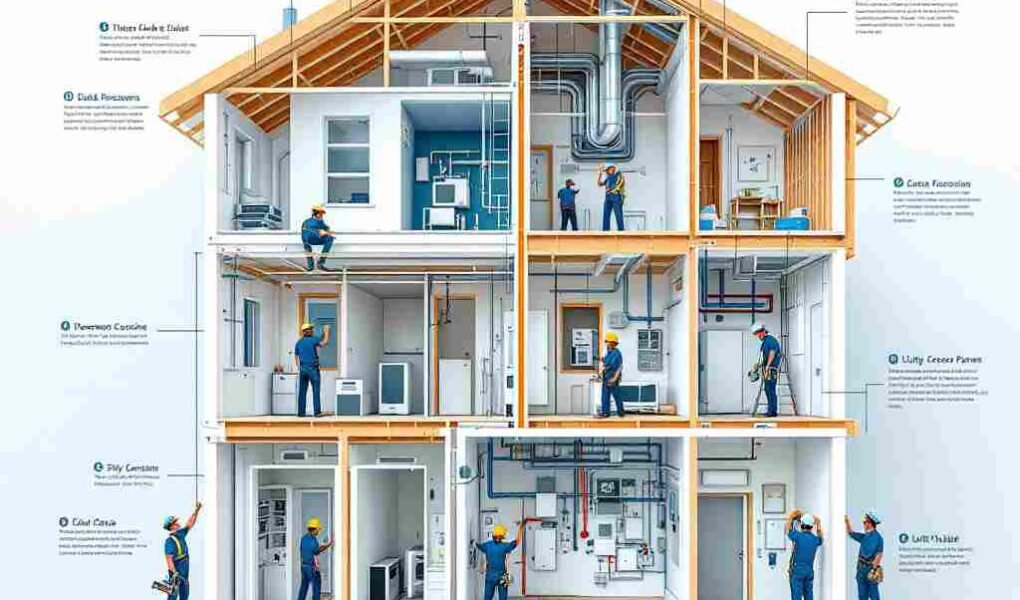Improving HVAC and Utility Access in New Construction With Flush Access Doors
Imagine this—you’re in a brand-new house, all shiny and modern, and everything’s running perfectly. Until it isn’t.
Suddenly, the HVAC starts wheezing like a chain-smoker, a pipe decides to reenact Niagara Falls inside the walls, and an electrician is playing hide-and-seek with a faulty circuit.
And what’s standing between you and a quick fix? Some geniuses buried all the essential systems behind drywall like ancient relics never meant to be seen again.
Cue the chaos: walls get torn open, ceilings come crashing down, repair bills skyrocket. And for what? Because someone thought, “Hey, who needs easy access to the things keeping the house alive?”
Let’s skip the hassle—flush access doors are the way out of this mess.
Why Is Maintenance Always a Struggle?
Because people value aesthetics too much. That’s why. Nobody wants a big, clunky access panel sticking out in their pristine, Pinterest-worthy walls. But guess what’s worse? An entire section of drywall hacked apart because you couldn’t reach a shut-off valve.
Here’s the cycle:
Hard-To-Reach Access Points: Great if you love unnecessary labor costs and technicians cursing your name.
Bulky Access Panels: Sticking out like a sore thumb, killing every ounce of design effort.
Endless, Expensive Repairs: Because ripping out sections of a house isn’t exactly cost-effective.
Panic Mode When Things Break: The absolute joy of realizing a tiny issue became a massive disaster because nobody planned for maintenance.
And it’s not like you can just not maintain HVAC and electrical systems in your house. These things don’t run on good vibes. They need checkups, fixes, and sometimes, complete overhauls.
What Are Flush Access Doors?
Simple: They’re hidden, sleek, and do their job without demanding attention like an attention-hungry reality TV star. They sit perfectly on the wall or ceiling, practically invisible, yet they open like a secret pass when needed.
They are functional without being ugly. And let’s be honest—if something can make home maintenance easier without turning your house into an industrial nightmare, why wouldn’t you use it?
Where Do You Need Them?
Check out these placement strategies for flush access doors in your house:
HVAC Systems
That unit that keeps your house from turning into a sauna during summer and an icebox in winter? It needs servicing. Put access doors near ductwork, air handlers, and any spot a technician might need to reach.
Otherwise, enjoy watching them carve a new hole into the ceiling.
Plumbing
A small leak behind the wall today is a full-blown flood tomorrow. Access doors near shut-off valves, drains, and main lines? Non-negotiable. Unless, of course, you enjoy mold colonies taking over your home.
Well-placed flush access doors make inspecting and repairing pipes simple, reducing the risk of costly repairs and downtime.
Electrical Panels
Electrical systems require occasional maintenance and troubleshooting, especially in houses with complex setups. Flush access doors near circuit breaker panels, junction boxes, and conduit runs give electricians a safe and convenient way to access wiring without tearing into walls.
Want an electrician to spend hours tracing a single wire? Make their job easier by giving them quick access to junction boxes, circuit breakers, and conduit runs.
This reduces the risk of them “accidentally” taking a hammer to your walls out of frustration.
Ceilings
Ductwork, wiring, sprinkler systems — all hiding up there, all waiting to fail spectacularly if ignored. Ceiling access panels let maintenance teams handle problems before they turn into full-scale disasters.
They have essential systems like ductwork, electrical wiring, or sprinkler pipes running through ceilings. Flush access doors installed in these areas provide easy entry for maintenance without affecting your room’s aesthetics.
Utility Rooms
Everything important is here—electrical panels, HVAC equipment, plumbing systems. Yet, people still think it’s okay to block access with storage boxes and random junk. Stop doing that. And install proper access points while you’re at it.
Placing access doors in key spots within these rooms helps maintenance teams reach important components without moving heavy equipment or dismantling walls.
Making New Houses Smarter (and Less of a Headache to Maintain)
Want to avoid a maintenance horror story in your new house? Follow these rules:
Plan Access Points From the Start: Including access doors and panels during construction is much easier than cutting them into walls later. Think about where HVAC units, plumbing lines, and electrical panels will go so they’re easy to reach when needed.
Add More Access Than You Think You Need: Some house parts may seem easy to reach now, but future repairs or upgrades could be tricky. Extra access doors in walls, ceilings, or utility rooms make maintenance faster and prevent unnecessary damage.
Keep Utility Areas Clear: HVAC and electrical rooms often become storage spaces, making it hard to reach important systems. Keeping these areas clutter-free makes repairs and inspections quick and hassle-free.
Leave Room for Future Upgrades: Technology changes fast, and HVAC or electrical systems may need upgrades. Extra space around key equipment and larger access doors can make future work much easier.
Make Safety a Priority: Good access isn’t just about convenience—it also helps keep a house safe. Ensuring access points are easy to find, well-ventilated, and secured when needed helps prevent accidents and keeps everything in shape.
Final Thought: Stop Making Home Maintenance Nightmares
Nobody cares how stunning a house looks if it’s a nightmare to maintain. Flush access doors are the unsung heroes that keep everything running smoothly without ruining the design.
If you want a functional, smart, non-frustrating home, start thinking about access now—not when it’s too late.




